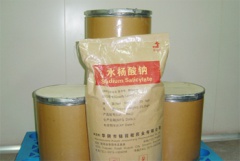Difference between revisions of "Sodium salicylate"
(Created page with "{{Infobox_Miscellaneous | image = Sodium_salicylate.jpg | origin = | stowage factor = | humid...") |
m |
||
| (One intermediate revision by the same user not shown) | |||
| Line 1: | Line 1: | ||
{{Infobox_Miscellaneous | {{Infobox_Miscellaneous | ||
| image = Sodium_salicylate.jpg | | image = Sodium_salicylate.jpg | ||
| − | | origin = | + | | origin = - |
| − | | stowage factor = | + | | stowage factor = - |
| − | | humidity and moisture = | + | | humidity and moisture = - |
| − | | ventilation = | + | | ventilation = - |
| − | | risk factors = | + | | risk factors = See text |
}} | }} | ||
| + | __TOC__ | ||
| + | ==Description== | ||
| + | Sodium salicylate is a sodium salt of salicylic acid. It can be prepared from sodium phenolate and carbon dioxide under higher temperature and pressure. Historically, it has been synthesized from methyl salicylate (found in wintergreen plants or the bark of sweet birch tree) by reacting it with an excess of sodium hydroxide and heating it under reflux.<br><br> | ||
| + | ==Application== | ||
| + | It is used in medicine as an analgesic and antipyretic. Sodium salicylate also acts as non-steroidal anti-inflammatory drug (NSAID), and induces apoptosis in cancer cells and also necrosis. It is also a potential replacement for aspirin for people sensitive to it. It may also be used as a phosphor for the detection of vacuum ultraviolet radiation and electrons. Preservative for paste, mucilage, glue and hides.<br><br> | ||
| + | ==Shipment / Storage / Risk factors== | ||
| + | Sodium salicylate; white crystalline scales or powder with a saline taste, shipped in drums or barrels. On exposure, the powder forms into a solid block with no therapeutic value. Soluble in water.<br><br> | ||
| + | The product is not listed as a dangerous cargo. Consult the applicable MSDS sheet for safe handling advice.<br><br> | ||
| + | |||
| + | [[Category: Products]] | ||
| + | [[Category: Oil and chemicals]] | ||
Latest revision as of 13:53, 12 August 2014
| Infobox on Sodium salicylate | |
|---|---|
| Example of Sodium salicylate |  |
| Facts | |
| Origin | - |
| Stowage factor (in m3/t) | - |
| Humidity / moisture | - |
| Ventilation | - |
| Risk factors | See text |
Sodium salicylate
Description
Sodium salicylate is a sodium salt of salicylic acid. It can be prepared from sodium phenolate and carbon dioxide under higher temperature and pressure. Historically, it has been synthesized from methyl salicylate (found in wintergreen plants or the bark of sweet birch tree) by reacting it with an excess of sodium hydroxide and heating it under reflux.
Application
It is used in medicine as an analgesic and antipyretic. Sodium salicylate also acts as non-steroidal anti-inflammatory drug (NSAID), and induces apoptosis in cancer cells and also necrosis. It is also a potential replacement for aspirin for people sensitive to it. It may also be used as a phosphor for the detection of vacuum ultraviolet radiation and electrons. Preservative for paste, mucilage, glue and hides.
Shipment / Storage / Risk factors
Sodium salicylate; white crystalline scales or powder with a saline taste, shipped in drums or barrels. On exposure, the powder forms into a solid block with no therapeutic value. Soluble in water.
The product is not listed as a dangerous cargo. Consult the applicable MSDS sheet for safe handling advice.











